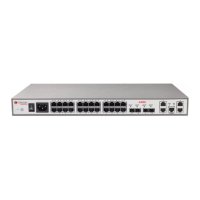A10E/A28E/A28F Configuration Guide
Figure 7-16 RRPS in switching status
Once there is link failure (such as link break), the failure adjacent node or interface will check
the fault immediately and send link failure packets to master node. The master node will
enable the first interface once receiving the packets, in the meantime, send packets to notify
other transmission nodes about the link failure and inform them to change transmission
direction. The data flow will be switched to normal link after the transmission nodes updating
forwarding entry.
When the failed link is restored, the failed node does not enable the blocked port immediately
until the new topology collection is stable. The origin node will find itself the master node,
after some time delay, it will block his first interface, and send Change packets to notify the
failed node enabling the blocked interface.
7.7.2 Preparing for configurations
Scenario
As a Metro Ethernet technology, Ethernet ring solves the problems of weak protection to
traditional data network and long time to fault recovery, which, in theory, can provide 50ms
rapid protection features and is compatible with traditional Ethernet protocol, is an important
technology options and solutions of metro broadband access network optimization
transformation.
RRPS technology is protocol, which through simple configuration achieves the elimination of
ring loop, fault protection switching, and automatic fault recovery function and makes the
fault protection switching time less than 50ms.
RRPS technology supports both single-ring and tangent ring networking modes, but not
intersecting ring networking. Tangent ring is actually two separate single rings, which has the
same configuration with common single ring.
Preconditions
Before configuring RRPS, configure interface physical parameters to make interface physical
layer state Up.

